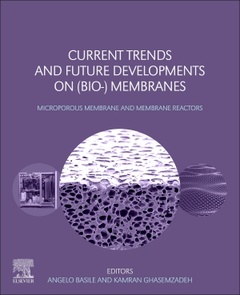Description
Current Trends and Future Developments on (Bio-) Membranes
Microporous Membranes and Membrane Reactors
Coordinators: Basile Angelo, Ghasemzadeh Kamran
Language: English
Subject for Current Trends and Future Developments on (Bio-) Membranes:
405 p. · 19x23.3 cm · Paperback
Description
/li>Contents
/li>Readership
/li>Biography
/li>Comment
/li>
Current Trends and Future Developments on (Bio-) Membranes: Microporous Membrane and Membrane Reactors focuses on the structure, preparation, characterization and applications of microporous membranes and membrane reactors, including transport mechanisms through a range of microporous membranes. It is a key reference text for R&D managers who are interested in the development of gas separation and water/waste treatment technologies, but is also well-suited for academic researchers and postgraduate students working in the broader area of strategic material production, separation and purification. Users will find comprehensive coverage of current methods, their characterization and properties, and various applications in gas separation and water treatment.
1. Introduction: Microporous membrane and membrane reactors in industrial applications 2. Microporous carbon membranes; structure, preparation, characterization and applications 3. Transport mechanism and modeling of microporous carbon membranes 4. Microporous carbon membrane reactors 5. Microporous silica membrane; structure, preparation, characterization and applications 6. Transport mechanism and modeling of microporous silica membranes 7. Microporous silica membrane reactors 8. Microporous zeolite membrane; structure, preparation, characterization and applications 9. Transport mechanism and modeling of microporous zeolite membranes 10. Microporous zeolite membrane reactors 11. Microporous polymeric membrane; structure, preparation, characterization and applications 12. Transport mechanism and modeling of microporous polymeric membranes 13. Microporous polymeric membrane reactors 14. Microporous graphene membrane; structure, preparation, characterization and applications 15. Transport mechanism and modeling of microporous graphene membranes 16. Microporous graphene membrane reactors
This book is a key reference text for R&D managers in industry interested in the development of microporous membrane and membrane reactors as well as academic researchers and postgraduate students working in the wider area of the membrane processes to energy conversion
Angelo Basile, a Chemical Engineer with Ph.D. in Technical Physics, is author of hundreds of papers, books, chapter-books, and Special Issues in the field of Membrane Science and Technology, with also various Italian, European and worldwide patents. He is an Associate Editor of various int. journals (IJHE, APCEJ, etc), Editor-in-Chief of the Int. J. Membrane Sci. & Techn., and member of the Editorial Board of more 25 int. journals. Today Basile is working at General TAG, Via Mastri Ligornettesi n. 28, Ligornetto 6853 – Switzerland.
Kamran Ghasemzadeh is an associate professor in the Faculty of Chemical Engineering at the Urmia University of Technology, Iran where he has been a faculty member since 2014. From 2016-2018, also, he was nominated as head of chemical engineering faculty. On the other hand, from August 2018, he is nominated as director of UUT research center in Urmia university of technology. His research interests lie in the area of membrane and membrane reactor processes, ranging from modeling to design to implementation. In recent years, he has focused on study of inorganic membranes (graphene, silica and palladium membranes) performances for gas separation and water treatment from both aspects of experimental and modeling point of views. He has collaborated actively with researchers in several other disciplines of chemical engineering, particularly simulation of chemical processes by commercial Comsol Multiphysics, Fluent and Aspen Hysys software. Moreover, he has succeeded to publish more than seventy ISI and conference papers, two patents, seven books and also more than forty book chapters. Hence, Kamran has served on roughly twenty conference and workshop program committees.
- Reviews gas separation and water treatment processes and relates them to various applications
- Outlines the use of microporous membranes in gas separations and water treatment
- Introduces the various types of microporous membranes (graphene, polymeric, etc.) and their mechanism of action
- Provides simulation models of the various processes




